Semantic SEO Checklist: 7 Proven Steps to Boost Rankings
Stop guessing what Google wants. Use this comprehensive 7-step semantic SEO checklist to build powerful topical authority, enhance context, and clearly communicate your page’s meaning to both users and search engines.
Why Your Content Isn’t Ranking (And How to Fix It)
You’ve done the keyword research. You’ve written what you believe is high-quality content. You’ve even built some backlinks. But your page is still languishing on page three or four of Google. Sound familiar? The frustrating truth is that this is one of the biggest SEO mistakes content creators make today. The answer is often that Google, despite its incredible sophistication, can’t fully understand what your page is truly about.
Modern search engines have evolved far beyond simple keyword matching. They are trying to understand concepts, context, entities, and user intent. They’re building a massive, interconnected map of human knowledge. If your content lacks the semantic signals—the clues that connect these dots—it will be overlooked, no matter how well-written or factually correct it is. This is where a powerful semantic SEO checklist becomes your most valuable asset. It moves you from thinking about isolated keywords to thinking about entire topics and their relationships.
Semantic SEO is the solution to this modern search puzzle. It’s an approach that focuses on meaning and relationships, helping Google understand your content on a deeper, more human-like level. It’s about teaching Google the “who, what, where, when, why, and how” of your content. By following our 7-step semantic SEO checklist, you will transform your content from a simple collection of keywords into a comprehensive, authoritative resource that both users and search engines will value and reward with higher rankings.
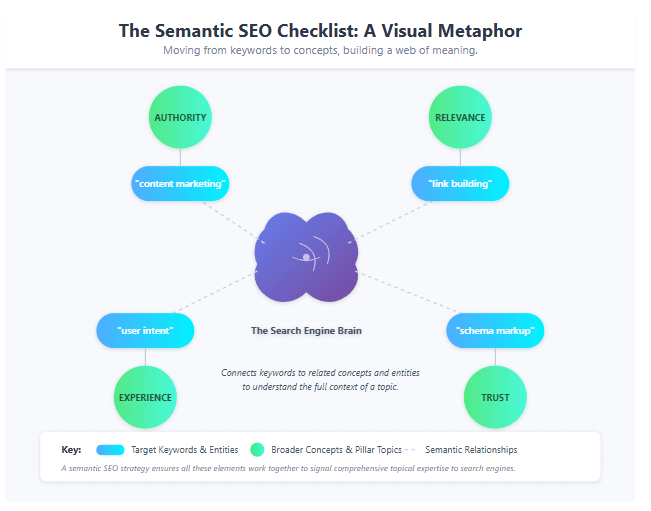
Your 7-Step Semantic SEO Checklist
Follow these proven, detailed steps to implement semantic SEO on your site and start building the topical authority necessary to boost your rankings and dominate your niche. This isn’t just another semantic SEO checklist; it’s a strategic framework for modern search success.
Master Your Topic Research Beyond Keywords
The foundation of any great semantic SEO checklist is a profound understanding of your topic. This goes far beyond identifying a primary keyword. You must become an expert on the topic landscape. Your goal is to map the entire conversation surrounding your subject, identifying related concepts, entities, questions your audience is asking, and subtopics they care about.
Start by using tools like AnswerThePublic and AlsoAsked to visualize the questions and prepositions surrounding your topic. These tools give you a direct look into the user’s mind. Next, analyze the top-ranking pages for your target query. Don’t just look at their keywords; look at the concepts they cover. What subtopics do they have sections for? What questions do they answer? What entities (people, places, organizations) do they mention? Your goal is to understand the topic so comprehensively that you can create content that’s more valuable and complete than anything currently available on page one. This deep research is the first, non-negotiable step on our semantic SEO checklist.
Action Items:
Build Content Clusters & Pillar Pages
Once you understand the topic landscape, you need to organize your content strategy around it. The most effective way to do this is with the content cluster model. This model is a cornerstone of our semantic SEO checklist because it establishes your site’s authority on a topic and creates clear semantic relationships for Google to follow.
The model works like this: Create one comprehensive “pillar page” that broadly covers the main topic. This page should be a long-form resource that touches on all the important subtopics. Then, create multiple “cluster content” pieces—individual articles or pages that dive deep into one specific subtopic mentioned in the pillar page. The crucial final step is to link from each cluster page back to the pillar page using descriptive anchor text. This structure sends powerful signals to Google that your site is an authoritative resource on the entire subject, not just one isolated aspect of it. It’s a way of saying, “We know so much about this topic that we’ve written a book about it (the pillar) and detailed chapters about every part (the clusters).” A well-executed cluster strategy is a game-changer for any semantic SEO checklist.
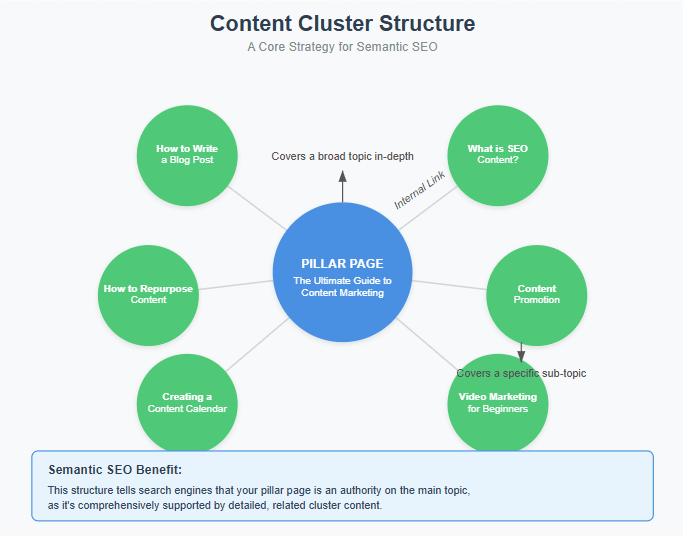
Action Items:
Create Comprehensive, Natural Content
With your research and structure in place, it’s time to create the actual content. The golden rule here is to write naturally, as if you’re explaining the topic to an interested friend. Google’s natural language processing (NLP) capabilities, powered by models like BERT and MUM, are exceptionally good at identifying content written for humans versus content written for algorithms. Keyword stuffing is a relic of the past and has no place on a modern semantic SEO checklist.
Instead, focus on providing comprehensive information that fully addresses the user’s needs and anticipates their follow-up questions. Incorporate synonyms, related terms, and variations of your main concepts throughout your content. This isn’t about LSI keywords (a largely misunderstood concept) but about using the natural language of the topic. For example, if you’re writing about “running shoes,” you would naturally also talk about “sneakers,” “jogging footwear,” “athletic shoes,” “cushioning,” “stability,” and “pronation.” This helps Google understand the topic from multiple angles and improves your chances of ranking for a wider range of queries. This step on the semantic SEO checklist is where you truly provide value to the reader.
Action Items:
Optimize Your On-Page Elements for Context
On-page elements provide crucial context about your content. Optimizing them to reinforce the semantic meaning of your page is a critical part of any semantic SEO checklist. This goes beyond simply including keywords—it’s about providing context clues that help both users and search engines understand what to expect from your content.
Create descriptive title tags that include context clues about the content type (e.g., “Guide,” “How to,” “Review,” “Best”). Use header tags (H1, H2, H3) to create a logical hierarchy that outlines your content’s structure, almost like a table of contents. Employ semantic HTML5 tags like <article>, <section>, <nav>, and <aside> to define different parts of your content and their relationships to each other. Don’t forget image alt text; describe images in detail, providing context and including relevant concepts. This helps search engines understand the visual content and its relationship to the surrounding text. For a full list of technical optimizations, this detailed on-page SEO checklist is an excellent resource to complement your semantic efforts.
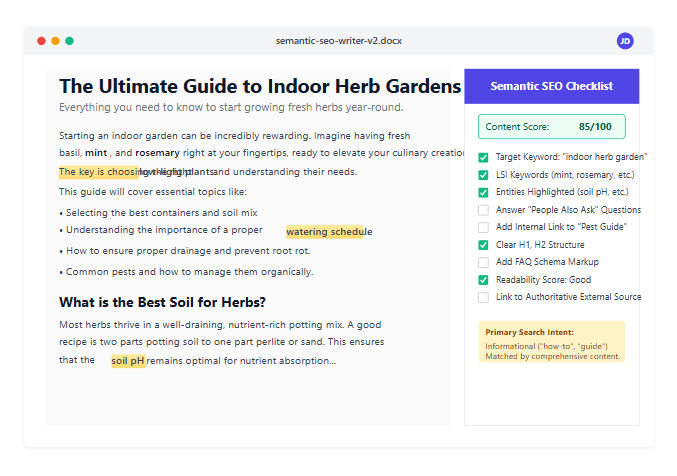
Action Items:
Implement Schema Markup for Direct Communication
If semantic SEO is about communicating meaning, schema markup is like having a direct phone line to Google. It’s one of the most powerful tools on our semantic SEO checklist. Schema is structured data (a standardized format) that you add to your website’s HTML to explicitly tell search engines what your content is about, how different pieces of information relate, and what entities are mentioned.
Using Schema.org vocabulary, you can mark up your content with specific types. For an article, you can specify the headline, author, date published, and image. For a product, you can define the price, availability, and reviews. For a recipe, you can list ingredients and cooking times. This clarity helps search engines understand your content with precision and can result in “rich snippets” or “rich results” in the search page (like star ratings, FAQs, or event details), which can significantly increase your click-through rate. Implementing schema is a proactive step on your semantic SEO checklist that removes any ambiguity about your content’s meaning.
Action Items:
Strengthen Your Internal Linking with Context
Internal links are the highways of your website. They create a web of connections that establishes clear topic relationships and distributes authority (link equity) throughout your site. When you link between related pages using descriptive anchor text, you’re helping both users and search engines discover more relevant content and understand how topics relate to each other. This is a vital, yet often overlooked, part of a complete semantic SEO checklist.
Review your internal linking structure to ensure it supports your content clusters. Every cluster page should link contextually to the pillar page. Look for opportunities to link between related cluster pages. Most importantly, use descriptive, context-rich anchor text. Instead of “click here,” use “learn more about on-page optimization.” The anchor text tells Google what the destination page is about, reinforcing its semantic relevance. A smart internal linking strategy makes your site more navigable for users and more understandable for search engines, solidifying your site’s topical authority. This step on the semantic SEO checklist ties your entire content strategy together.
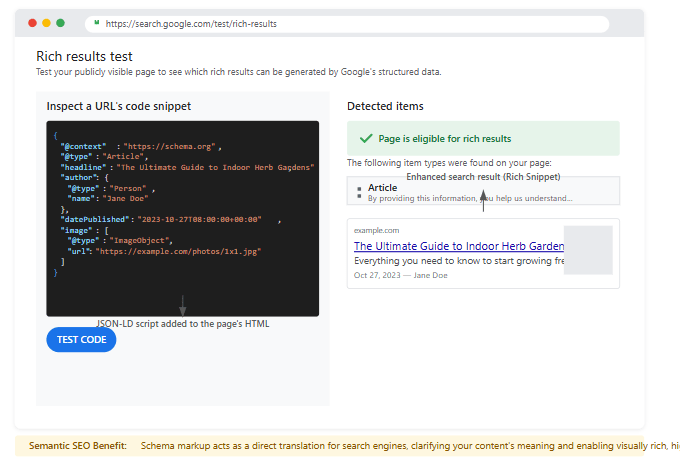
Action Items:
Measure, Refine, and Update Your Strategy
Semantic SEO is not a “set it and forget it” strategy. It’s an ongoing process of measuring performance, identifying gaps, and refining your approach. The final step on our semantic SEO checklist is to establish a cycle of continuous improvement. You need to track what’s working and what isn’t.
Move beyond tracking rankings for individual keywords. Instead, monitor your rankings for entire topic clusters. Are you seeing improvements across a range of related queries? Use Google Search Console to analyze the performance of your pillar and cluster pages. Pay close attention to user engagement metrics like time on page, bounce rate, and pages per session. If users are spending a long time on your content, it’s a strong signal that you’re successfully meeting their needs. Regularly audit your content to find opportunities for improvement. As your industry evolves and new questions emerge, update your content to stay current and maintain its authority. Conducting a comprehensive advanced SEO audit periodically is a great way to ensure your semantic SEO strategy is on track and delivering the results you want. This final step ensures your semantic SEO checklist remains a living document that adapts to the changing search landscape.
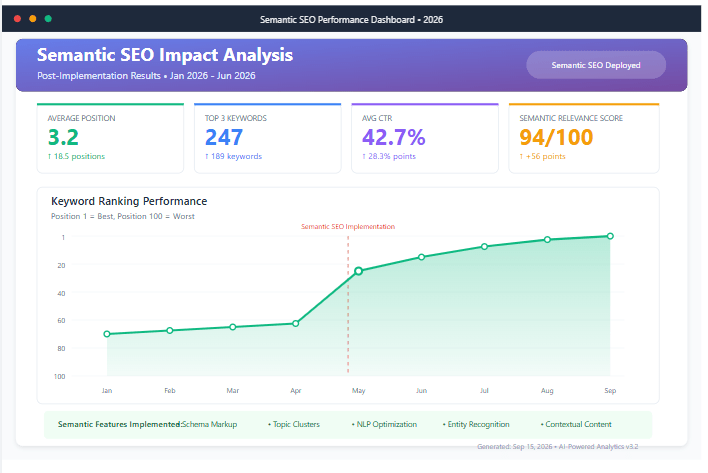
Action Items:
Get Your Free Semantic SEO Checklist PDF
Ready to implement these strategies? Download our comprehensive, printable semantic SEO checklist PDF. It includes all 21 action items from our guide, plus additional tips, a content brief template, and implementation notes to keep you on track.
Download Your Free Semantic SEO Checklist
Enter your email below to receive the complete semantic SEO checklist PDF plus weekly SEO tips to help you stay ahead of the curve.
Frequently Asked Questions
Traditional SEO focused primarily on keywords, backlinks, and technical elements to improve rankings. Semantic SEO, which our semantic SEO checklist is built upon, goes beyond these factors to focus on meaning, context, and relationships between concepts. While traditional SEO asks “what keywords should I target?”, semantic SEO asks “what topic should I cover comprehensively and how can I establish context?”. Both approaches are important, but semantic SEO aligns more closely with how modern search engines understand and evaluate content. It’s less about manipulating algorithms and more about effectively communicating meaning to both users and search engines.
Semantic SEO is a long-term strategy that typically takes 3-6 months to show significant results. Unlike some traditional SEO tactics that might produce quicker (but less sustainable) results, following a semantic SEO checklist builds a foundation of topical authority that compounds over time. Initial improvements in user engagement metrics like time on page and reduced bounce rates may appear sooner, as users find your content more comprehensive and helpful. Rankings for long-tail and question-based queries often improve first, followed by more competitive terms as your topical authority grows. Patience and consistency are key.
While some aspects of our semantic SEO checklist involve technical implementation (like schema markup), many elements are content-focused and don’t require technical expertise. The checklist includes both technical and non-technical items, allowing you to start with what’s most accessible to you. For technical elements like structured data, there are user-friendly tools and WordPress plugins that can help with implementation. As you become more comfortable with semantic SEO principles, you can gradually incorporate more technical aspects into your strategy. The most important part is the strategic thinking about topics and context.
Absolutely. In fact, a semantic SEO checklist can be a great equalizer for small businesses and bloggers. It allows you to compete with larger sites by demonstrating deeper expertise and authority on a specific topic. Instead of trying to outspend competitors on backlinks, you can out-think them by creating more comprehensive, semantically rich content that better serves the user. Google’s algorithms are increasingly rewarding this depth and quality, making it a perfect strategy for those who can produce expert-level content, regardless of their budget size.